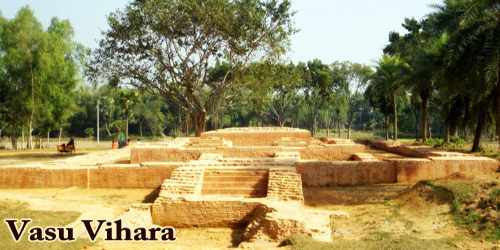Vasu Vihara or ‘Vasu Vihar’ (Bengali: ভাসু বিহার), locally known as Narapatir Dhap, is a complex of two rectangular monasteries and a semi-cruciform shrine of the Post-Gupta period. It is one of the famous archaeological sites in Bangladesh. It is one of the ancient Buddhist heritage of Bangladesh. It is located at about 6 km west of mahasthangarh (Mahasthangad) on the northern part of village Bihar, under Bihar union of Shibganj Upazila in Bogra district, about 500m west of the Nagar river. Three of the five mounds of the site have been fully excavated. They have revealed two monasteries and a shrine from either the pre-Pala period or the post-Gupta period. The large monastery has an open space in the center and rooms for the monks surrounding it. The smaller monastery has a similar layout, with a veranda at the front. In 1973–74, the excavation was started here and in the consecutive two sessions, it was resumed. 18 ancient clay seals, mostly from the Pala dynasty, and two brick-built structures have been discovered by the archaeologists during an excavation. There is also excavation work taking place on a second temple and you’re able to get a close-up look at some of the archaeological processes. Archaeologists have already discovered hundreds of antique items here, including plaques, precious stones, ornamental tablets, and clay lamps.
Bhasu Vihara is about six kilometers away from the ancient city of Mahasthangarh. Visiting it is one of the highlights of the region but, despite its significance, is usually quiet. It is easy to explore it on foot and also get some lovely views of the surrounding scenery. There is an open space among the surroundings of the small rooms of the monks. It seems there was an auditorium in the open space. Nearly 800 antiques have been found here. Among them miniature statues, plaques, and seals, beads of precious stones, ornamental bricks and tablets, clay lamps, including vessel fragments are notable. Human figures, animals and birds, and various geometric and floral compositions dominate the basic themes of the terracotta plaques. A large number of ornamental bricks, which were used to decorate the outer wall of the shrine along with terracotta plaques, have been obtained. The common designs are the lotus petal, stepped pyramid, dental edge, wavy lines, floral, and chain motifs; the most common designs are lotus petal and stepped pyramid as we find at mainamati, paharpur, and other Buddhist sites. More than 250 inscribed terracotta sealings, out of which more than a hundred are decipherable, have been obtained in excavations.
















